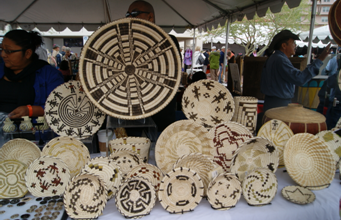The Demonstrators and Non-Profits Committee identifies about 35 artists to display, demonstrate, and discuss their art to the public, as well as facilitates booths for non-profit organizations. This Committee determines the locations and any special needs, provides whatever is needed including supervising final set-up just prior to the Saturday opening. This Committee acts as monitors for this area.
The Demonstrators/Non-Profits Chair is appointed by the Fair Chair. The Demonstrators/Non-Profits Chair, in turn, may recruit others to share the workload. The Chair works closely with the Museum’s Marketing Department in arranging accommodations for the demonstrators.
The Chair:
- Reports progress and problems to Fair Chair and attends all Fair meetings scheduled by the Fair Chair.
- Invites the Fair Chair to all committee meetings. The Fair Chair will attend whenever possible.
- Acknowledges by thank you note, or other means, appreciation for the work done by volunteers working on this committee.
- Sets up meetings and makes all arrangements necessary with the Museum Events Coordinator.
- Reviews the content of the public section of the Guild website to determine the accuracy and currency of the information pertaining to the work of the committee. Sends necessary changes to webmaster@heardguild.org.
- At the end of the year, reviews the committee job description posted on the Guild website and in the Committee Notebook. They should both be the same. Makes any necessary changes and sends to the President Elect and to webmaster@heardguild.org.
- Attends the Indian Fair & Market Wrap Up Meeting after the and submits in duplicate e the annual Committee Report (unbound) using the Sample Committee Report as a guide. These reports will be distributed to the incoming Committee Chair and Fair Chair. An electronic copy of the report in MSWord format is sent to the Webmaster, or similar text format, for posting on the website.
Tasks
- Prepare and submit a line item budget to the Fair Chair.
- Create a resource file of artists who have demonstrated or have expressed a willingness to demonstrate.
- Create a resource file of non-profit organizations that have participated or who might want to participate.
- Contact a selected list of demonstrators and non-profit organizations asking for their availability and interest in participating.
- Mail contracts to entertainers who have agreed to perform detailing their performance schedule, honorarium, housing arrangements, and travel reimbursements (if any).
- Consult with the Artists Exhibitors Chair regarding number of available demonstrator booths and non-profits tables.
- Consult with the Fair Chair, Staging Chair, and Signage Chair about set up requirements, changing booth locations, and sign needs.
- Consult with the Museum’s Facilities Manager about the installation of necessary electrical connections.
- Arrange with the General Food Chair to provide drinking water for the demonstrators.
Time Line
- Begin formulating a list of possible demonstrators and non-profit groups.
- Reserve a block of rooms to be used by next year’s demonstrators.
August
- Prepare and submit a budget to the Fair Chair.
- Contact a selected list of demonstrators about their availability and interest.
September
- Mail confirming letters to those expressing an interest explaining the arrangements.
- Determine the number of rooms needed from each demonstrator.
- Arrange accommodations.
November
- Attend General Fair meeting with the Division and Area Chairs.
- Consult with the Fair Chair, Staging Chair, and Signage Chair about set up requirements for demonstration area and signage needs.
January
- Attend General Fair meeting with the Division and Area Chairs.
- Consult with the Fair Chair, Staging Chair, and Signage Chair about set up, booth, and sign needs.
- Consult with the Museum’s Facilities Manager about electrical needs.
- Consult with the General Food Chair about drinking water for the demonstrators.
- Consult with the Scrip Sales Chair about food tickets for the demonstrators.
- Mail packets containing contracts, accommodation information, performance schedule, entry passes, parking, and travel reimbursements (if any).
- Begin receiving contracts and making final housing and travel arrangements.
February
- Attend final general Fair meeting to confirm previous arrangements for drinks, snacks, etc.
- Prepare vouchers for fee payments and present them to the Guild Treasurer.
March
- Greet and orient entertainers upon their arrival on Friday of Fair week.
- Serve as host/hostess and representative for demonstrators during their stay.
- Arrange for the payment of honoraria and housing cost with the Guild Treasurer and submit vouchers (with receipts) for any other budgeted expenses.
- Prepare and submit a written report to the Chair of the Indian Fair & Market.
April
- Review website description of committee work and send changes to webmaster@heardguild.org. Make sure job descriptions are the same in the notebook and website. Send changes to the President Elect and to webmaster@heardguild.org.
- Attend the Indian Fair and Market Wrap Up Meeting and submit three copies of the annual Committee Report (unbound) using the Sample Committee Report as a guide. The hard copy reports will be distributed to the incoming Committee Chair, the Fair Chair, and the Library Archives. Also, a copy of the report in MS Word is sent to the Webmaster for Guild records.
4/12/12
